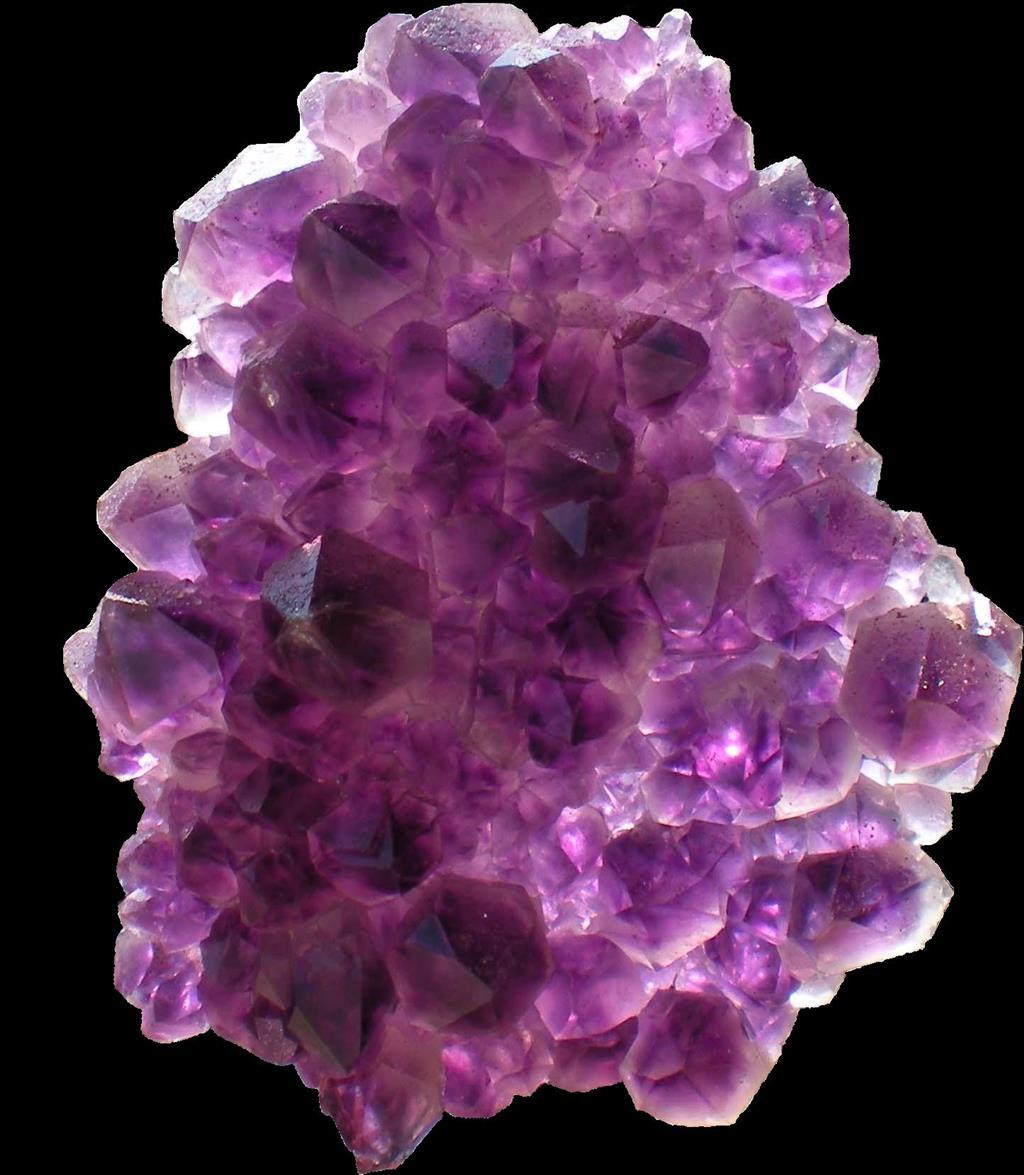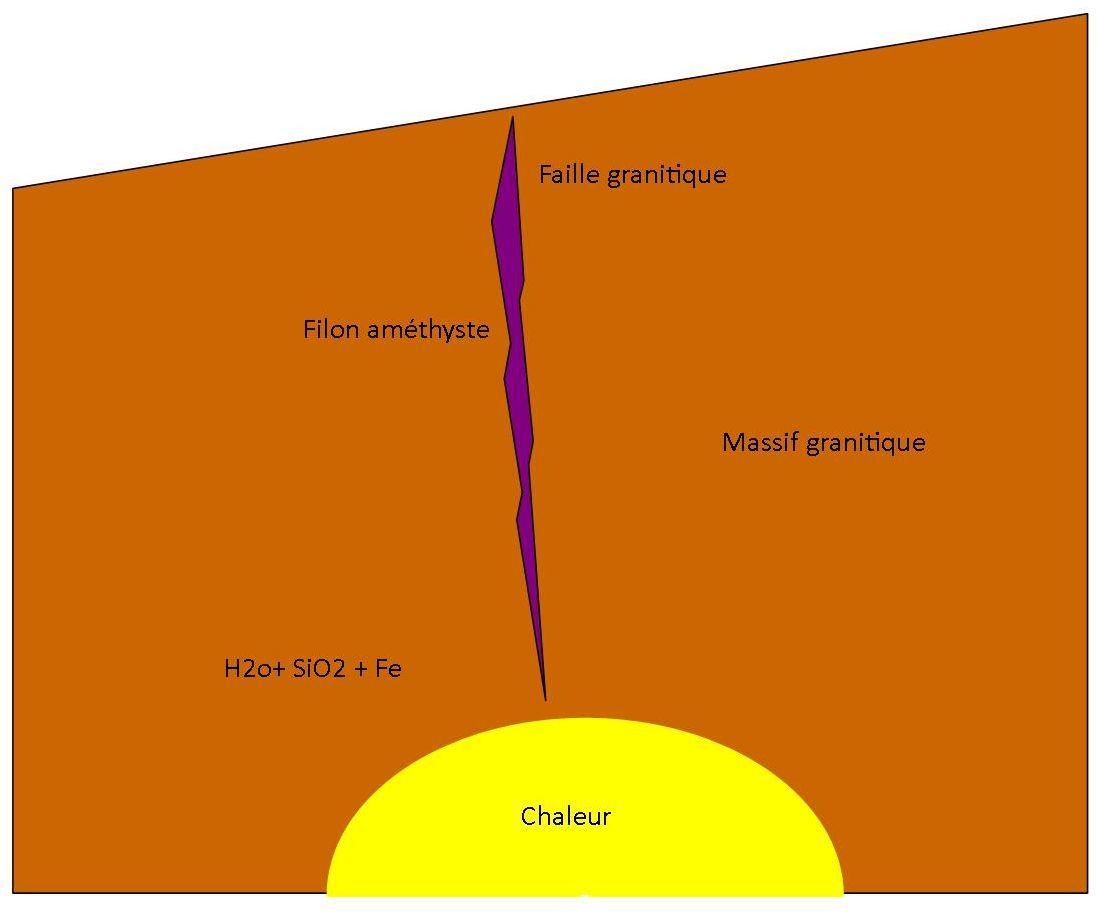FRANCAIS
Le nom Améthyste trouve son origine dans le mot grec "Amethystos", qui signifie «protéger contre l'ivresse» et fait référence au mythe de la création de l'améthyste.

Appelé Dionysos par les Grecs et Bacchus par les Romains, le dieu du vin était en quelque sorte le « mauvais garçon » de la mythologie antique. En dépit de la mission divine qui était la sienne – mettre fin aux chagrins et aux peines –, Dionysos était lui-même l’auteur de méfaits divers et variés, particulièrement après avoir bu quelques verres de vieux vin. On raconte qu’un jour, Dionysos ivre, offensé par un mortel, jura de se venger sur le premier humain qu’il croiserait sur sa route. La première personne qu’il rencontra fut Améthyste, une belle et innocente jeune fille, fervente adoratrice de la déesse Artémis… Dionysos en colère lança sur elle deux tigres affamés, prêts à la déchirer en pièces, et remplit sa coupe de vin pour pouvoir jouir du spectacle. Artémis, à qui rien n’échappait, intervint et transforma Améthyste en statue de quartz, d’une pureté aussi grande que sa vertu. Si ce sortilège permit de protéger la jeune fille, il n’était pas possible de le révoquer ; accablé de remords, Dionysos versa d’amères larmes dans sa coupe et la renversa en s’écroulant. Des gouttes de vin vinrent asperger la statue, faisant ainsi naître la pierre pourpre que nous connaissons sous le nom d’améthyste.
L’histoire de l’améthyste en Auvergne commence avec la reine Margot. Résident à proximité, à Usson, la reine entendit parler de ces fameux quartz violets. Elle les rendit populaires en portant de somptueux bijoux.
Par la suite le commerce avec les espagnols connut une longue période de succès. Les pierres au départ fut emmené vraisemblablement par les pèlerins en marche vers St Jacques de Compostelle et dont une des routes passent par Issoire non loin de là. Les joailliers espagnols se rendaient annuellement de Catalogne en Auvergne pour acheter de belles pierres. Néanmoins ce commerce s’arrêta brusquement et ce ne fut qu’au 19ème siècle que les gisements furent ré exploités avec l’ouverture de la taillerie de Royat.
Améthyste :
Variété de la famille du Quartz, de teinte violette
Symbole : SiO2
Densité : 2,6
Dureté : 7 Mohs
Couleur : Violet, vert, rose
Mode de gisement : système filonien, intrusions dans un massif granitique, 30 km autour du Vernet la Varenne
Origine : magmatique plutonique, orogenèse varisque
Âges des cristallisations : de 440 Ma à 280 Ma
L’améthyste est un quartz coloré en violet. l'Améthyste cristallise dans certains filons hydrothermaux La coloration a été provoquée par une longue exposition à un environnement faiblement radioactif. Les quelques très rares atomes de fer perdus dans le réseau du quartz sont alors excités part la radioactivité et deviennent alors des « centres de couleur » qui donnent à l’améthyste sont aspect violacé. Mais attention ! Cette coloration n’est pas permanente et si on chauffe l’améthyste, elle redevient incolore d’une manière irréversible.
L' Améthyste se décolore à partir de 250. Elle peut prend une teinte jaune et imiter la « Citrine ». Elle peut prendre une teinte verte et imiter la "Prasiolite ". Elle peut devenir laiteuse et imiter la" Pierre de lune "
Comment se forme les cristaux de quartz dans les filons hydrothermaux ?
Etape 1: Fracturation du socle
De nombreuses failles se sont formées dans le socle cristallin du Massif Central lorsque ce dernier a commencé à s'affaisser.
Etape 2: Circulations hydrothermales de hautes températures
La formation de la chaîne hercynienne a dégagé une énergie considérable. Ces processus ont conduit au dégagement d'une forte chaleur. Une forte chaleur (~400°C) provoque le relargage de l'eau contenue dans les roches qui va dissoudre et entraîner avec elle de nombreux minéraux présents en petite quantité dans la roche. La silice (SiO2), abondante dans les roches cristallines, est le plus important minéral dissous et constitue donc la gangue des filons. D'autres éléments solubles à haute température peuvent l'accompagner selon la température et la composition de la roche : le fer (Fe) pour l’améthyste.
L'eau chaude étant moins dense que la roche, les fluides minéralisés vont remonter vers la surface en suivant les failles existantes (effet de pompe hydrostatique). La température des fluides diminuant au cours de leur remontée, les minéraux vont cristalliser et se déposer sur les parois de ces failles. On aboutit ainsi à la formation d'un filon hydrothermal.

Pour valider, cette earth cache vous devez répondre à ces questions :
- De quels éléments chimiques se composent l’améthyste
- A quel élément chimique lui doit-on sa couleur violette
- Comment peut-on modifier la couleur de l’améthyste
- Sur le chemin de Montfort qui mène à la maison de l’améthyste, en partant à pied du bourg, vous longerez un mur en pierre le long de ce mur en pierre un bloc de granit chargé d’améthyste est visible, Quelle est la couleur de l’améthyste ? Quelle est la couleur du quartz, mica et feldspath composant également cette pierre ? (waypoint 1)
Loguez cette cache 'Found it' et envoyez-moi vos propositions de réponses soit via mon profil, soit via la messagerie geocaching.com (Message Center), et je vous contacterai en cas de problème.
Cette earth cache, vous emmène à proximité de la maison de l’améthyste, il n’est pas nécessaire de rentrer à l’intérieur de l’exposition pour répondre aux questions
Si vous souhaitez en savoir plus sur cette belle pierre, plusieurs sites avec des possibilités de visites :
http://www.amethystes-auvergne.com/
http://www.amethyste-geosite-auvergne.com/
ENGLISH
Amethyst of Auvergne
The name Amethyst has its origin in the Greek word "Amethystos", which means "protect against drunkenness" and refers to the myth of the creation of amethyst.

Called Dionysus by the Greeks and Bacchus by the Romans, the god of wine was somehow the "bad boy" of ancient mythology. In spite of his divine mission - to put an end to sorrows and sorrows - Dionysus himself was the author of various misdeeds, especially after drinking a few glasses of old wine. It is said that one day, drunk Dionysus, offended by a mortal, swore revenge on the first human he would cross in his path. The first person he met was Amethyst, a beautiful and innocent girl, a fervent worshiper of the goddess Artemis ... Angry Dionysus threw two hungry tigers on her, ready to tear her to pieces, and fill her cup of wine to be able to enjoy a spectacle. Artemis, to whom nothing escaped, intervened and turned Amethyst into a quartz statue, of a purity as great as his virtue. If this spell helped protect the girl, it was not possible to dismiss him; overwhelmed with remorse, Dionysus poured bitter tears into his cup and toppled it to the ground. Drops of wine came to sprinkle the statue, thus giving birth to the purple stone that we know as amethyst.
The history of Amethyst in Auvergne begins with Queen Margot. Resident nearby, in Usson, the queen heard about these famous purple quartz. She made them popular by wearing sumptuous jewels.
Thereafter the trade with the Spaniards knew a long period of success. The stones at the start were probably taken by the pilgrims on their way to St Jacques de Compostela and one of the roads passes by Issoire not far from there. Spanish jewelers went annually from Catalonia to Auvergne to buy beautiful stones. Nevertheless this trade stopped abruptly and it was not until the 19th century that the deposits were re exploited with the opening of the cutting of Royat.
Amethyst:
Variety of the Quartz family, purple in color
Symbol: SiO2
Density: 2.6
Hardness: 7 Mohs
Color: Purple, green, pink
Deposit mode: vein system, intrusions in a granite massif, 30 km around Vernet la Varenne
Origin: plutonic magmatic, Variscan orogeny
Ages of crystallizations: from 440 Ma to 280 Ma
Amethyst is a colored quartz in purple. Amethyst crystallizes in some hydrothermal veins Staining was caused by long exposure to a low-level radioactive environment. The very few rare iron atoms lost in the quartz network are then excited by the radioactivity and then become "centers of color" which give the amethyst its purplish appearance. But beware ! This coloring is not permanent and if we heat the amethyst, it becomes colorless in an irreversible way.
Amethyst fades from 250. It can take a yellow hue and imitate the "Citrine". It can take a green hue and imitate the "Prasiolite". It can become milky and imitate the "moonstone"
How are quartz crystals formed in hydrothermal veins?
Step 1: Fracturing the pedestal
Many faults formed in the crystalline basement of the Massif Central when the latter began to subside.
Step 2: High Temperature Hydrothermal Circulation
The formation of the Hercynian chain has generated considerable energy. These processes led to the release of a strong heat. A strong heat (~ 400 ° C) causes the release of the water contained in the rocks that will dissolve and bring with it many minerals present in small quantities in the rock. Silica (SiO2), abundant in crystalline rocks, is the most important dissolved mineral and therefore constitutes the gangue of veins. Other elements soluble at high temperature can accompany it according to the temperature and the composition of the rock: iron (Fe) for the amethyst.
Since hot water is less dense than rock, the mineralized fluids will rise to the surface following the existing faults (hydrostatic pump effect). As the temperature of the fluids decreases during their ascent, the minerals will crystallize and settle on the walls of these faults. This leads to the formation of a hydrothermal vein.

To validate, this earth cache you must answer these questions :
- What chemical elements are made of amethyst
- What chemical element does it owe its violet color
- How can I change the color of amethyst
- On the path of Montfort which leads to the house of amethyst, starting on foot from the village, you will follow a stone wall along the stone wall a granite block loaded with amethyst is visible, What is the color of amethyst? What is the color of quartz, mica and feldspar also making up this stone? (waypoint 1)
Log this cache 'Found it' and send me your proposed answers either through my profile or via the messaging geocaching.com (Message Center), and I will contact you in case of problems.
This earth cache, takes you near the house of amethyst, it is not necessary to go inside the exhibition to answer questions

Si vous souhaitez en savoir plus sur cette belle pierre, plusieurs sites avec des possibilités de visites :
http://www.amethystes-auvergne.com/
http://www.amethyste-geosite-auvergne.com/